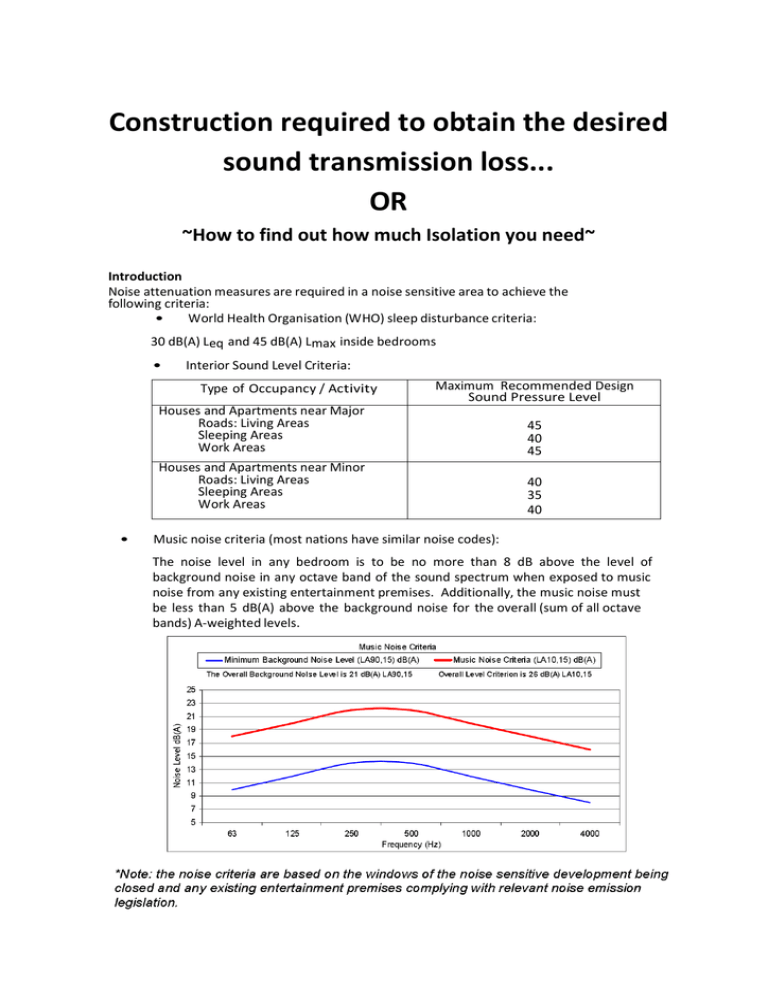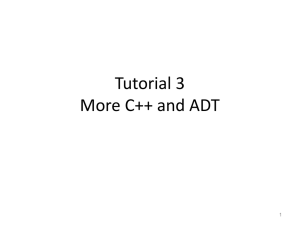
Construction required to obtain the desired sound transmission loss... OR ~How to find out how much Isolation you need~ Introduction Noise attenuation measures are required in a noise sensitive area to achieve the following criteria: • World Health Organisation (WHO) sleep disturbance criteria: 30 dB(A) Leq and 45 dB(A) Lmax inside bedrooms • Interior Sound Level Criteria: Maximum Recommended Design
Type of Occupancy / Activity Sound Pressure Level Houses and Apartments near Major Roads: Living Areas 45 Sleeping Areas 40 Work Areas 45 Houses and Apartments near Minor Roads: Living Areas 40 Sleeping Areas 35 Work Areas 40 • Music noise criteria (most nations have similar noise codes): The noise level in any bedroom is to be no more than 8 dB above the level of background noise in any octave band of the sound spectrum when exposed to music noise from any existing entertainment premises. Additionally, the music noise must be less than 5 dB(A) above the background noise for the overall (sum of all octave bands) A‐weighted levels. For example; see the chart below which represents the octave band for various musical instruments: Redrawn by John Schneider. See John R. Pierce, e Science of Musical Sound (New York, 1992), pp. 18‐19; Donald E. Hall, Mucical Acoustics: An Introduction (Pacific Grove, California, 1991), inside back cover; and Edward R. Tufte, Visual Explanations (Cheshire, Connecticut, 2001), p. 87. The table below shows a summary of the peak levels of various musical instruments. It can be seen that some instruments are quite capable of generating very high sound levels. Instrument Peak Level (dB SPL) French Horn 107 Bassoon 102 Trombone 108 Tuba 110 Trumpet 111 Violin 109 Clarinet 108 Cello 100 Amplified Guitar >115 Drums >120 So, depending on the use of the music room or studio, your isolation requirements can vary greatly. A dubbing room will require high isolation for the voice booth even though the average level of the spoken voice is only about 75 decibels, A weighted. This is mainly due to the need to keep the recordings clean and free of external noises. Mix & mastering engineers will work at volumes from 65 to 90 decibels, averaging around 80db. Full range music played at 90db peak will require at least 50 decibels of isolation to prevent their working levels from disturbing noise sensitive neighbors. A noise level of 70 decibels @ 1kHz is quite different from the same noise level @ 50Hz. The 1kHz tone will be perceived to be much louder than the 50Hz tone. This is due to the sensitivity of the inner ear. This phenomenon offers some help when designing a sound isolation partition or system. However, human hearing is not the only factor to be considered when building acoustic isolation. A music studio will need isolation from the elements as well as man‐made VLF noise. The rumble of thunder, trains, and heavy trucks & machinery, often not heard but felt, can ruin an otherwise good recording. Here, you must determine if it is in your best interest to isolate for these VLF noises as it can become a very, very expensive endeavor. Concrete Block Walls Concrete masonry units (concrete blocks) are usually sufficiently heavy that walls constructed from them provide STC ratings of about 45 to 55 simply by sealing the block surface. Adding materials such as sand or grout to the cores of the masonry units will cause them to perform much like solid blocks. The increase in transmission loss is due to the increase in weight/mass. Concrete block walls commonly have gypsum board applied to each face as a finishing material. Resilient connections and sound absorbing material in cavities are just as important in block walls as they are in wood or steel frame construction. The mass‐air‐mass resonance is also important. If the air gap behind the gypsum board is too small, the sound transmission losses can be reduced relative to the unfinished wall. ‐ Even using adhesive to attach gypsum board directly to concrete can result in a thin film of air a few mm in thickness trapped behind the gypsum board and a deleterious mass‐air‐mass resonance. Reduced sound transmission losses caused by the mass‐air‐mass resonance are often the cause of a low STC for a potentially good concrete block wall. An increase in the air gap of just a few centimeters can increase the STC considerably. STC ratings of 60 or more can readily be achieved with a concrete block wall if it is correctly designed and constructed. As mentioned above, reduced sound transmission losses caused by the mass‐air‐mass resonance are often the cause of a low STC for a potentially good concrete block wall. For Example; Sketches of sections of resilient channels (to the right of the chart below) and measured sound transmission loss (TL) with and without the use of resilient channels to mount the gypsum board. Note the mass‐air‐mass resonance frequency is for only one layer of gypsum board (16mm). At very low frequencies the sound transmission loss actually decreases. This resonance frequency is determined by two things; a.) The mass of the gypsum board, and b.) The size of the air gap. Therefore while the use of resilient channel and/or isolation clips is beneficial for reducing sound transmission at voice frequencies, it is usually inadequate for use in music studios due to the decrease in isolation at low frequencies. Gypsum Board Walls The mechanical connection between the layers of gypsum board can be reduced by the use of staggered wood studs, separate rows of wood studs, or a single row of wood studs with resilient metal furring strips to support the gypsum board layers independently of each other. Non‐load‐bearing steel studs are usually resilient enough to provide adequate mechanical decoupling between the layers for a non‐decoupled partition. The presence of the sound absorbing material increases the STC by about 8 points relative to the same wall without sound absorbing material. Walls with 16 mm board would be better than those with 13 mm board by a few points. Again, light‐weight non‐decoupled partitions will yield poor low frequency isolation and are not recommended for music studios. In contrast to the values in the table below, the common internal partition used in single family homes with gypsum board attached directly to both sides of the wood studs has an STC rating of about 33. The addition of sound absorbing material in this type of wall increases its rating by about only 3 points, because the sound energy is transmitted directly from one layer of gypsum board to the other through the studs. The sound absorbing material in the cavity is of much less benefit than it would be if the layers were decoupled, in which case most of the sound would be transmitted through the air in the cavity. The table below shows that STC values of 60 or more can be obtained if the air space is large enough and enough gypsum board is used. Such values have been measured in buildings as well as in laboratories. STC Ratings for Walls Formed From Two Layers of Gypsum board Number of Layers of Gypsum board on Each Wall Surface Wall construction 1+1 1+2 2+2 38 x 89 mm (2 X 4s ‐ 1.5" by 3.5" actual) wood studs with 48 resilient steel channels on one side [40] 52 [44] 56 [52] Staggered 38 x 89 mm wood studs 50 [41] 53 [47] 55 [52] Double row of 38 x 89 mm wood studs with small gap between them 57 [46] 60 [52] 63 [57] 90 mm steel studs 45 [39] 49 [45] 56 [50] 60 63 150 mm (6") load‐bearing steel studs with resilient metal 58 channels on one side *Values not in brackets [] are for walls filled with sound absorbing material. Values in brackets are for walls without sound absorbing material. Rigid mechanical connections are the acoustical equivalent of an electrical short circuit or a thermal bridge in an insulated wall and must be avoided. Amount and Location of Absorptive Material The amount of absorption in the cavity has a significant effect on the sound transmission ‐ the greater the fraction of the cavity filled with absorption, the higher the sound transmission loss. The sound transmission loss continues to increase with increasing thickness of the absorptive material. With the cavity half‐filled with absorptive material, the sound transmission loss was about 5 dB less than that obtained by filling the cavity completely. ‐ the greater the fraction of the cavity filled with absorption, the higher the sound transmission loss. See chart below for testing examples: Note: the best performance in tests has been obtained using the low density fiberglass as absorption material. If absorptive material is compressed between the gypsum board surfaces, it can transmit vibration directly from one surface to the other, therefore care should be taken not to compress the cavity fill. Stud Type and Screw Spacing Fact: The panel resonance shifts to a higher frequency (and the STC is reduced more), the more rigidly the stud and screws constrain the gypsum board. The resonance is at its highest frequency for wood studs with the screws close together, and at its lowest frequency for the more flexible steel studs with the larger screw spacing. See Drawing below: The frequency at which the minimum STL occurs depends strongly on the stud spacing ‐ the smaller the spacing, the higher the frequency at which the dip occurs. Although the effect is stronger with wood studs, dependence on stud spacing also affects low frequency performance with steel studs. It should also be noted that several attachment details intended to reduce coupling between the studs and the gypsum board have been tested, but none offered a large improvement relative to conventional constructions such as non‐load bearing steel studs or wood studs with resilient channels. Therefore the use of foam tape or other special caulk or CLDM between the studs and the gypsum board is not recommended for an increase in transmission loss. Building/Isolation elements An important feature of a well constructed isolation partition is properly sealed junctions which aid in the reduction of noise transferred via flanking paths. A sound‐rated system will not perform adequately if joints and junctions are not properly sealed. Flanking is the transfer of noise through paths around a building/isolation element, rather than through the building element directly. Flanking paths occur through: • gaps and cracks in a building element; • incorrectly sealed junctions between two materials; • noise passing through gaps and weaknesses around building elements; and • penetrations in building elements from building services. Older buildings can develop acoustic problems as they age due to the likelihood of gaps and cracks in building elements increasing in size and sealed elements failing thus increasing the size and number of flanking paths and subsequently increasing the likelihood of significant noise problems. As flanking paths are the simplest problem to rectify when attempting to reduce external noise ingress, it should be the first consideration. Windows: Where openable windows are required, awning windows with opening sashes are preferable over sliding or pivoting windows because when they are closed, they achieve a positive compression seal against the window frame. Doors: Glazed and standard hinged doors are preferable to sliding doors as they are able to achieve a positive compression seal against the door frame when fitted with acoustic seals. Door bottom drop seals will be required if your door stop & rubber seal system does not extend 360 degrees around the door on the threshold. External Walls and Roof‐Ceiling Systems An important feature of well constructed external walls and roof‐ceiling systems is properly sealed junctions, which aid in the reduction of noise transferred via flanking paths (gaps at the edge of building elements that allow sound to travel through). Even a sound‐rated system may not perform adequately, if joints and junctions are not properly sealed. The following is required: • Full‐mortar joints should be used when a sound‐rated masonry wall system is used. • The depth of flexible caulking compound in joints should be sufficient to maintain the acoustic rating of the construction. Typically, the depth should be equal to or greater than the width of the joint. Suitable backing rods are generally required. • Joints in dissimilar materials may open up if there is building movement. It is important that the acoustic seal in joints accommodates any building movement. Services and Penetrations To reduce noise transfer via flanking paths it should be ensured that all penetrations, joints and junctions are sealed airtight with a flexible caulking compound. The design of a wall or roof ‐ ceiling system should consider services and penetrations from other building elements. Penetrations in a system can compromise its acoustic performance and will require extra consideration. For external walls it is also important not to chase services into masonry or concrete walls. • All penetrations in sound‐rated building elements should be neatly cut or drilled. Avoid excessively sized penetrations. • The wall around any large penetration should be rebuilt with the same material. Small gaps at penetrations can be sealed with suitable mastic. • The normal tolerance in building construction should be considered when installing penetrations, and at wall/floor junctions. • Gaps around all penetrations in sound‐rated walls or ceilings should be treated and sealed to maintain acoustic ratings. • Sealing should be effective, resilient, resistant to the surrounding environment, and designed to last for the life of the building. Ventilation Ventilation is movement of air, typically between an indoor space and the outside. In an enclosed space ventilation is required to exchange indoor air with outdoor air to replenish oxygen and to remove moisture, odors, smoke, heat, and airborne bacteria. Ventilation is one of the most important factors for maintaining healthy indoor air quality in a building and the Building Code of many countries requires that any occupied room within a residence be ventilated with outdoor air. It is important to understand that the provision of mechanical ventilation and air conditioning are not necessarily the same. Air conditioning by use of a split system AC unit does not provide outside air, but conditions the inside air to achieve the required comfort levels (either heating or cooling). Studio rooms are sealed airtight for sound insulation purposes, therefore mechanical ventilation is required, and where air is drawn directly from outside appropriate filtering will be needed. Baffling will also be required to maintain the sound insulation specifications. Summary & Conclusion 1. Calculate the existing sound transmission loss & the corresponding frequency spectrum. 2. Determine the level required by your application. 3. If additional sound transmission loss is required, determine the necessary additions based on worst‐case partitions because the weakest partitions will compromise all others. For example, if most of your walls/partitions are concrete exhibiting STC60+ transmission loss and you have one partition that is one layer of standard (13mm) gypsum board on both sides of steel studs (STC34), then the STC34 partition must be improved to match the concrete partition. It would be a waste of time and resources to do otherwise as this is the weak link and, as the metaphor goes, will break the chain. High STL partitions are required to have resilient coupling to any part of the partition that is in contact with the building structure. This means that all wall partitions must be floated using appropriately resilient material such as low dynamic stiffness rubber. Natural Rubber has the lowest dynamic stiffness of all the common materials. The synthetic material, Neoprene, comes next. On the following pages are my top recommended partitions and their associated STC ratings. Note: If the studs are increased in size to 140mm (2 X 6 stud) and the air gap to 50mm (2") the increase in the total air gap is half again as much (from 205mm to 330mm) and therefore the isolation rating is increased to approximately STC‐72. Also note that the stud spacing is 61cm on centers (24") which results in a lower coincidence dip, extending the low frequency isolation. Each time either the total weight/unit area of the wall or the distance between the layers is doubled, an improvement of about five STC points should result. ‐ And this is for WOOD 2 X 4 studs! The use of steel studs will improve the system by 1‐2 STC points and due to the added resilience of the steel studs will also improve the low frequency transmission loss. Block/Brick/Cement: (mass is your friend) The following chart is from Riverbank Testing data representing a standard cement wall/floor partition with an added 10cm (4") partition with a surface density of 150.6kg/m² (31.3lbs/ft²). For example; Ytong 4,0 standard blocks, 10cm thick have a surface density of 62kg/m² (13lbs/ft²), so with Ytong 4,0 the STL will be approximately 5‐6 db less than shown in this chart. 2" air TRANSMISSION LOSS (db) gap Air gaps without Basic with fiber glass infill wall/floor Frequency
75% ‐‐‐‐‐‐‐‐Gap Sizes‐‐‐‐‐‐‐‐ partition Band
fiber glass 0" 1" 2" 3" 4" infill 800Hz 51 db STL 52 db STL 85 db STL 86 db STL 87 db STL 86 db STL 88 db 1000Hz 52 db STL 55 db STL 88 db STL 88 db STL 88 db STL 87 db STL 89 db 1250Hz 55 db STL 58 db STL 93 db STL 93 db STL 92 db STL 91 db STL 95 db 1600Hz 58 db STL 61 db STL 97 db STL 96 db STL 95 db STL 93 db STL 97 db 2000Hz 60 db STL 63 db STL 97 db STL 101 db STL 99 db STL 97 db STL 97 db 2500Hz 62 db STL 65 db STL 101 db STL 104 db STL 101 db STL 101 db STL 100 db 3150Hz 65 db STL 67 db STL 104 db STL 105 db STL 107 db STL 103 db STL 104 db 4000Hz 58 db STL 71 db STL 105 db STL 106 db STL 105 db STL 104 db STL 106 db 5000Hz 70 db STL 74 db STL 102 db STL 101 db STL 99 db STL 99 db STL 103 db STC 54 57 76 79 80 82 82 INR ‐27 17 17 17 18 IIC ‐24 68 68 68 69 As can be seen from the data above, two block walls separated with a 2" air gap with no absorption material fill can have a rating of STC‐79 & with fiberglass fill STC‐82. This is incredible! But this is only possible if the partition is properly floated to at least half the lowest usable frequency. And all partitions in the isolated room must match this specification or they will become the weak link in the system. If you have any questions/comments, please let me know. I am happy to help you to understand these important parameters in music studio design. Sincerely, John H. Brandt ©2012 all rights reserved





